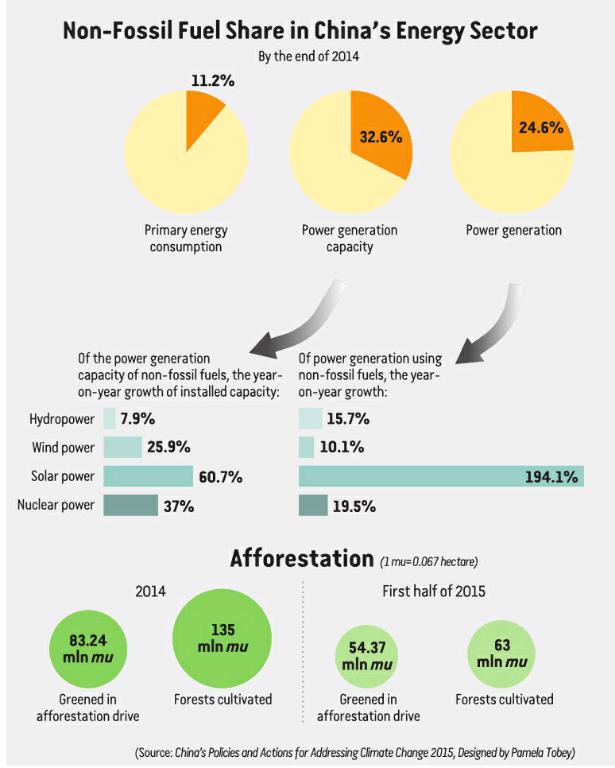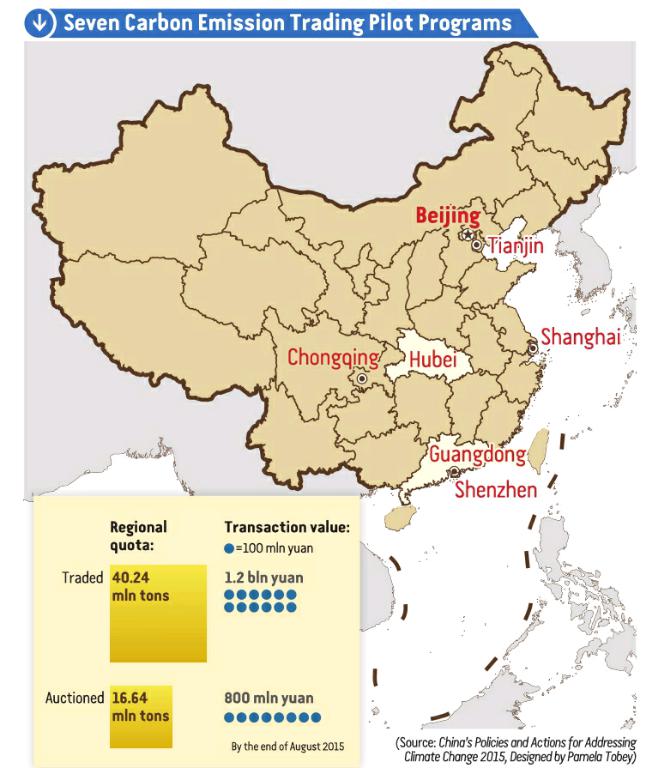Tempering A Warming Climate
2016-01-27ByDengYaqing
By+Deng+Yaqing
Paris is currently experiencing an unprecedented amount of hustling and bustling for the next two-week period. Thousands of government leaders, negotiators, scholars and non-governmental representatives are gathering at the Paris UN climate change summit. Their goal: to finish sealing a fully articulated and legally binding agreement on curbing climate change after 2020.
“By now, a total of 160 nations have submitted their Intended Nationally Determined Contributions (INDCs) on tackling climate change after 2020 to the secretariat of United Nations Framework Convention on Climate Change (UNFCCC), and its expected that other nations will follow suit,” said Xie Zhenhua, Chinese special representative on climate change at a press conference in Beijing on November 19. This reflects “that the world is making concerted efforts to address the increasingly grave global problem,” said Xie.
“Humans clearly influence the climate system, and recent anthropogenic emissions of greenhouse gases are the highest in history,” the Intergovernmental Panel on Climate Change (IPCC) said in an assessment report released on November 2, 2014. “Each of the last three decades have been successively warmer on [the Earths surface] than any preceding decade since 1850. The period from 1983 to 2012 was likely the warmest 30-year period of the last 1,400 years in the Northern Hemisphere,” said the IPCC report.
According to calculations by the UNFCCC, without an agreement in Paris, the global tem-perature might experience an increase of 4-5 degrees Celsius by 2100, which will far exceed the critical limit of rising by no more than 2 degrees Celsius above pre-industrial levels. Reviewing the developmental history of the Earth, one can find that the temperature differences between the pre-industrial world and the last ice age was a mere 4-7 degrees Celsius, which indicates that small changes in temperatures may mean big differences for the planet.
Still, the joint actions of the 146 countries that had submitted their INDCs by October 1 may lead the average global temperature to rise by around 2.7 degree Celsius by 2100. This outlines a failure in achieving the goal of rising below the 2-degree-Celsius limit, according to a report released by the UN on October 30.
Following the submission of INDCs, at a ministerial meeting in Beijing on October 30-31, four large developing countries—India, China, Brazil and South Africa—agreed that the Paris summit should be based on the principles of the UNFCCC. In particular, they stressed the equality principle, and the principles of common but differentiated responsibilities and respective capabilities.
Developing countries have already taken more active measures to cope with climate change than their developed counterparts. The developed world should further reinforce their emission reduction endeavors and ensure sustained and sufficient support in terms of financing, technology development and transfer. That is in addition to the capacity to support developing countries, especially the promised $100 billion a year by 2020 and intensified support after 2020, agreed on by the four countries.
“Now, what underlies the success of the Paris summit is whether the principle of common but differentiated responsibilities can be fully respected and whether the developed world will fulfill its promise to provide developing countries with financial and technological support. That is the foundation to establishing mutual political trust,” Xie stressed.
Chinas endeavors
As the largest greenhouse gas emitter and the second largest economy, China shows a firm determination to carry out global climate governance by unveiling a series of joint announcements with the United States, France, India, the EU and Brazil and taking an initiative to submit its INDCs, said Li Peilin, Vice President of Chinese Academy of Social Sciences.
In early November in Beijing, Chinese President Xi Jinping and his French counterpart Fran?ois Hollande made a joint statement on climate change, pledging to promote a working program to speed up pre-2020 efforts in mitigation, adaptation and support during the Paris summit. Both agreed that any global treaty on climate change reached in the summit should include a mechanism to monitor progress on emission cuts every five years.
Predating that, President Xi had also met U.S. President Barack Obama in Washington, D.C. and outlined the new steps that the two countries will take to deliver on pledges made in 2014 to slash their greenhouse gas emissions. China will launch its national emission trading system in 2017, covering key industrial sectors such as iron and steel, power generation, chemicals and building materials. In addition, the nation will channel a total of 20 billion yuan($3.13 billion) to set up the China South-South Climate Cooperation Fund to assist developing countries in the fight against climate change, matching the United States similar pledge.
Aside from that, the Chinese Government has been committed to carrying out industrial restructuring, advancing energy conservation and efficiency of energy use, optimizing energy structure and boosting the forest carbon sink.
In 2014, carbon dioxide emissions per unit of GDP fell by 6.2 percent year-on-year and 15.8 percent compared to 2010, accomplishing 92.3 percent of the carbon intensity reduction goal set by Chinas 12th Five-Year Plan (2011-15). Energy consumption per unit of GDP fell by 4.8 percent, compared to the 3.7 percent that was registered in 2013.
Efforts were also made to eliminate 4,858-megawatt thermal power generation units, 31.1-million-ton backward steel production capacity, 87 million tons of cement production capacity and 37.6 million weights of plate glass cases. In addition, a total area of 83.24 million mu (5.55 million hectares) were planted in an afforestation drive and 135 million mu (9 million hectares) of forests were raised in 2014. In the first half of 2015, a total of 54.37 million mu (3.62 million hectares) were managed in afforestation initiative, and 63 million mu (4.2 million hectares) of forests were cultivated, according to Chinas Policies and Actions for Addressing Climate Change 2015.
Pressing forward
In its INDCs submitted in June, China promises to peak its carbon dioxide emissions by 2030, lower carbon dioxide emissions per unit of GDP by 60 percent from 65 percent, jack up the share of non-fossil fuels in the primary energy mix to roughly 20 percent and increase the volume of forest stock by roughly 4.5 billion cubic meters over the level in 2005.
“China has also laid out adaptation measures, such as improving its early-stage alarming and forecasting system, adopting disaster reduction and prevention actions and promoting infrastructure construction for addressing climate change,” said Xie, noting that more measures were included in a national climate change adaptation plan released earlier.
Apparently, the pre-convention exchanges and communications of the Paris summit are more efficient and adequate than that of the Copenhagen summit, which will facilitate the process of wrapping up a legally binding treaty, said He Jiankun, Deputy Director of National Expert Committee on Climate Change.
Countries draw up their own INDCs according to their respective development stage and national condition. This is more rational and viable than forcing countries to reach rigid, allocated targets, said He, suggesting that combating climate change is not a zero-sum game but a mutually beneficial action.
